Which Surveys to take across B2B Customer Experience Journey?
Read More
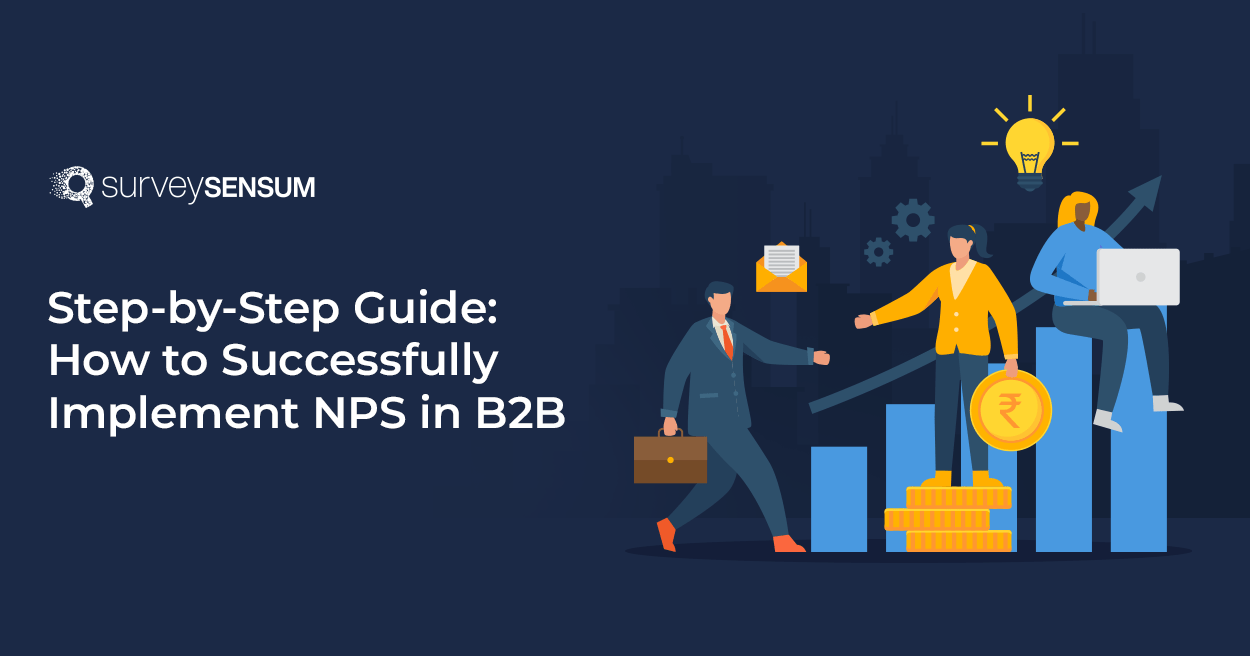
How successful is your Net Promoter Score B2B Program?
Did you encounter any challenges while implementing it?
During the implementation of the Net Promoter Score program in B2B, many brands face several challenges – ‘what objective to choose?’, ‘the right questions to ask’, ‘when to send the survey’ or ‘whom to send the survey’, and many more.
Not just that, effectively analyzing survey results for maximum benefits can also pose a challenge.
Also, while NPS is very common in B2B (and brands majorly focus on that), it’s essential to acknowledge that CSAT surveys can play a critical role at certain touchpoints, providing relevant insights to enhance your understanding of customer sentiment.
To tackle these issues and make the most of NPS implementation for your business, we interacted with diverse B2B clients and devised a practical 4-step guide.
This comprehensive Net Promoter Score B2B guide will help you create appropriate NPS and CSAT questions, determine the ideal timing to send the survey, select the right recipients for the survey, and more.
Let’s get started.
But first, let’s understand how is NPS different in B2B.
While the fundamental concept of NPS remains the same in both B2B and B2C contexts, the application and interpretation of NPS may vary due to the unique characteristics of B2B relationships.
Let’s understand these differences.
| B2B | B2C | |
| Customer Loyalty | Involve higher stakes and longer-term commitments | Short-term commitments |
| Revenue Stream | Different customer segments have different types of payment plans and one segment can be worth more than the other one | Customer segments are fairly broad and with standard payment plans |
| Complexity of Relationships | More complex and multifaceted involving longer sales cycles, multiple decision-makers, and ongoing contracts | Simpler and more transactional |
| Duration | Generally long-term and may span over many years | Generally shorter and more transactional |
| Ticket Size | Larger ticket sizes due to the larger scale of purchases | Smaller ticket sizes, reflecting individual consumer spending patterns |
So, the differences are well laid out, let’s now understand how to implement NPS in B2B.
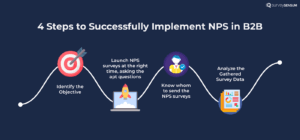
Here are the 4 steps to implement NPS in B2B:
So, let’s start with the first step.
Knowing the objective is really crucial when it comes to implementing NPS surveys in B2B. It helps you to focus your efforts, gather relevant feedback, and gain valuable insights into customer satisfaction and loyalty.
So, how can you do this? – By identifying the objectives depending on the pain points that you’re facing.
Here are the 4 common challenges that B2B companies face:
To understand your customer’s perception, you need to
Companies lose $1.6 trillion per year due to customer churn! And according to Forrester, it costs 5 TIMES MORE to acquire new customers than it does to keep an existing one.
This statistic shows how losing customers in B2B can have a big impact on your business’s success. Not only does it impact revenue, but it also affects your brand reputation and market position. So, to prevent customer churn and contract non-renewals, you must:
To resolve this pain point, you must:
You can leverage promoters for referrals and word-of-mouth (WoM) in B2B by the following:
Once you identify your business pain point then accordingly you can launch NPS surveys.
→ Read more on when to launch NPS surveys.
Now that the objective is clear, you need to determine when to launch these surveys because timing is crucial.
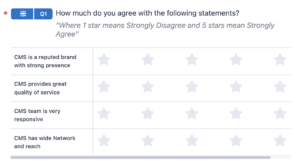
Here’s an example of CMS, a leading B2B service company, implementing NPS for the first time. Their objective was to understand how their clients truly felt about their services. After conducting this NPS survey, they identified both detractors and promoters among their customers.
Similarly, here are the touchpoints of other B2B industries on which you can launch NPS surveys and ask the right questions.
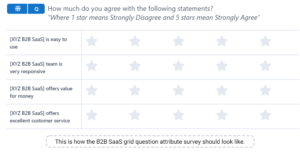
In B2B SaaS, there are multiple touchpoints on which you can send NPS surveys, but sending the surveys is not sufficient. You must ask the right questions to gather hidden insights that will help you to improve customer satisfaction.
Semesterly – decision maker To measure relationship and overall customer satisfaction quarterly and semesterly from the user or decision-maker.
| B2B SaaS | When to Conduct the Survey? | Which Survey to Launch? | Question Type | Whom to Send the Survey? | Why Launch Survey? |
| Onboarding | 2 weeks after sign-up | Onboarding Experience Survey | CES or CSAT | New customers | To measure the effectiveness of onboarding |
| Customer Support | After resolving an issue | Customer Support Satisfaction Survey | CSAT | Customers who received support | To assess customer satisfaction with support |
| New feature launch | One Week after release | Product Feedback Survey | CSAT and CES | Product users | To gather insights for product improvement |
| Product Usage and Overall Relationship | Quarterly or semesterly (every 6 months) | Relationship NPS | rNPS |
Quarterly – product user
Semesterly – decision maker
|
To measure relationship and overall customer satisfaction quarterly and semesterly from the user or decision maker |
You can ask the following questions NPS question for B2B SaaS:
In the B2B SaaS NPS Question, the common key attributes can be:
Improve your B2B SaaS product by launching product feedback survey in just under 5 minutes with SurveySensum
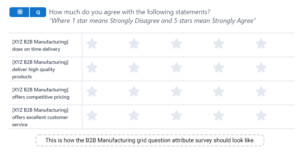
In B2B Manufacturing, companies launching NPS surveys at specific touchpoints can provide valuable insights into customer satisfaction and loyalty. With that, you can also identify areas for improvement, and foster long-term relationships with your clients.
| B2B Manufacturing | When to Conduct the Survey? | Which Survey to Launch? | Question Type | Whom to Send the Survey? | Why Launch Survey? |
| Order Delivery | Upon product delivery or after product delivery | Delivery Satisfaction Survey | CSAT | Customers who received orders | To measure satisfaction and identify areas for improvement |
| Post-Purchase | 6- Monthly after purchase | Product Feedback | CSAT | Existing customers | To gather insights for product improvement and usage patterns |
| Customer Support | After resolving an issue | Customer Support Satisfaction Survey | CSAT | Customers who received support | To measure satisfaction with support and identify areas to improve |
| Overall Relationship | Every 6 months | Relationship NPS | rNPS | Decision Makers | To build a relationship and measure their overall satisfaction level |
While creating surveys, you can ask the following questions NPS question for B2B Manufacturing:
In the B2B Manufacturing NPS Question, the common key attributes can be:
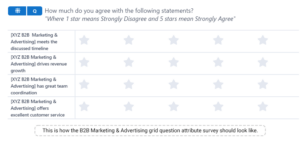
In the realm of B2B marketing and advertising, NPS surveys shine as illuminating gems. How?
Imagine you are running a B2B Marketing agency. You’ve completed a contract and now you send a relationship NPS survey to know your client’s experience. Positive responses highlight campaign successes, while any negative feedback guides you to improve and refine your marketing strategies. With this feedback, you also get to know about renewing their contract.
This is how NPS surveys became your compass, guiding you to forge stronger bonds, exceed expectations, and unveil the pinnacle of success.
| B2B Marketing & Advertising | When to Conduct the Survey? | Which Survey to Launch? | Question Type | Whom to Send the Survey? | Why Launch Survey? |
| NPS After Project Ends | After the contract ends (3 or 6 months) | Project NPS | NPS | Project participants | To measure overall customer satisfaction quarterly and semesterly |
| Relationship NPS after long project ends (1-2 years) | Every 6 months | Relationship NPS | rNPS | Contract participants | To build relationships and gauge the satisfaction level |
The right NPS questions that you can ask are:
In B2B Marketing & Advertising, some relevant attributes to ask in the NPS questions are
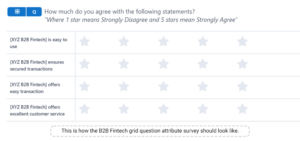
In B2B Fintech, companies launching customer feedback surveys at the right touchpoint can help them understand their customer sentiment, make data-driven decisions, and continuously evolve to meet client needs, ultimately driving success and profitability.
| B2B Fintech Touchpoints | When to conduct the Survey? | Which Survey to Launch? | Question Type | Whom to Send the Survey? | Why Launch Survey? |
| Onboarding | After sign-up or integration | Onboarding Experience Survey | CSAT | New customers or integrated clients | To assess the effectiveness of onboarding and integration |
| Product Usage | Ongoing basis or periodically | Product Satisfaction Survey | CSAT | Product Users | To measure satisfaction with your fintech product. |
| Overall Relationship | Every 6 months | Relationship NPS | rNPS | Users and Decision Makers | To build and measure overall relationships, customer satisfaction, and track changes over time. |
| Customer Support | After resolving an issue | Customer Support Satisfaction Survey | CSAT | Customers who received support | To measure satisfaction with support and identify areas to improve |
You can ask the following NPS questions:
In the B2B fintech NPS Question, some common attributes are
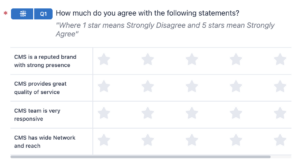
CMS, a B2B service, recognizes the significance of mapping customer journeys with SurveySensum. By launching targeted surveys at key touchpoints, they collect valuable feedback. This data is then analyzed and utilized to continuously enhance their B2B service offerings.
| B2B Service | When to Conduct the Survey? | Which Survey to Launch? | Question Type | Whom to Send the Survey? | Why Launch Survey? |
| Service Delivery | After project completion | Service Satisfaction Survey | CSAT | Clients who received service | Measure customer satisfaction with the service delivered |
| Customer Support | After resolving an issue | Customer Support Satisfaction Survey | CSAT | Clients who received support | Measure satisfaction with support and identify areas to improve |
| Overall Relationship | After 3 or 6 months | Relationship NPS | rNPS | Decision Makers | To build and assess customer relationship with their satisfaction level |
Following are the survey question examples:
In the B2B Service, NPS Question, the common key attributes can be:
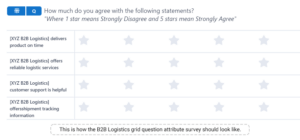
In the B2B logistics industry, optimizing the customer journey can position themselves as trusted partners in their client’s supply chain and logistics operations. This enriches their shipping experience.
| B2B Logistics Touchpoints | When to conduct the Survey? | Which Survey to Launch? | Question Type | Whom to Send the Survey? | Why Launch Survey? |
| Delivery Experience | After order delivery | Delivery Satisfaction Survey | CSAT | Customers who received orders | To measure customer satisfaction with the delivery experience |
| Customer Support | After resolving an issue | Customer Support Satisfaction Survey | CSAT | Customers who received support | To measure satisfaction with support and identify areas to improve |
| Overall Relationship | Periodically during the account management phase or upon request | Account Relationship Survey | Relationship NPS | Key account Decision Makers | To evaluate the strength of the business relationship and assess the overall customer satisfaction and loyalty |
Some examples of NPS scale questions are:
In the B2B logistics NPS Question, the common key attributes can be:
These attributes capture the quality of delivery services, responsiveness of the logistics provider, and the overall experience of working together.
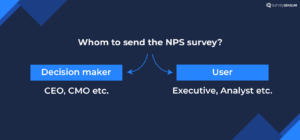
Your NPS survey is ready to launch but to whom you’re going to send surveys?
You can send surveys to either the DECISION MAKER or USER of the product.
But wait – Which accounts to prioritize?
Here’s how CMS analyzes the received data and takes action on it.
CMS took a proactive approach. Their CMO personally visited detractors, engaging in physical meetings to understand their concerns and improve the overall customer experience. This unexpected level of attention delighted unhappy customers, resulting in an improved NPS score and an influx of positive feedback.
The idea behind the meeting with the promoters was to gain insights into their positive experiences and identify the strengths of the company. This dedicated effort to gather and analyze feedback allowed CMS to build stronger customer relationships and pave the way for business growth and success.
So, to analyze the gathered data you have to:
This is how you can analyze the feedback and improve your NPS score.
Companies with high NPS scores tend to experience faster revenue growth compared to their competitors. A leading example is Amazon Prime. CIRP research has shown that 73% of people who try out Amazon Prime become paid members. And after the first year, 91% of the members renew their subscription for a second year, and 96% of those members pay for a third year as well.
So, with these 4 steps, you can implement a B2B net promoter score effectively. But only implementing NPS is not enough because NPS is not just about the score, it’s what you do with it that matters the most. This is why after implementing NPS in B2B, you also need to take action on the feedback by closing the feedback loop. Let’s see how to do that.
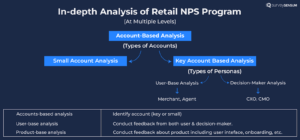
To effectively close the feedback loop and drive meaningful improvements, a comprehensive account-based analysis is crucial. There are two primary types of accounts: Small accounts catering to small businesses and key accounts serving larger enterprises.
Here we’ll focus on the key account-based analysis since it involves gathering feedback from a significant number of customers.
Key Account-Based Analysis: Within the key accounts, you will encounter two distinct personas: Users and decision-makers.
Small Account-Based Analysis: Small accounts cater to small businesses, and their feedback can provide valuable insights into their specific needs and challenges. Although there may be a larger number of small accounts, their individual feedback can collectively guide improvements to enhance overall customer satisfaction.
Tip 1: Involve the Company’s Leadership The active participation of the company’s CEO or CXO is instrumental in demonstrating the organization’s commitment to customer feedback. Their involvement encourages all teams to take necessary actions. If direct participation is challenging, leverage customer feedback reports to illustrate the importance and impact of customer insights. Sharing NPS reports and survey insights can foster engagement and alignment across the organization.
Tip 2: Leverage Promoters and Positive Feedback Harness the power of promoters – satisfied customers who provide positive reviews and testimonials. Share these positive experiences with your internal teams to inspire them and instill a customer-centric mindset. Cultivate a culture of continuous improvement by showcasing how customer satisfaction is driving success.
By incorporating these strategies into your feedback loop process, you can create a customer-centric approach that drives continuous improvement and fosters long-term success for your business.
But what happens when you send the survey and don’t get enough response rates to make the analysis?
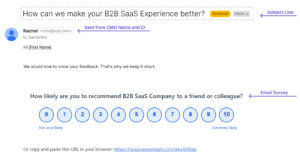
You’ve launched your NPS surveys successfully but do you know the best strategies that you can use to boost your survey response rate?
Here you go –
Now, the NPS program in B2B is implemented successfully, but one question still remains – does NPS really work for B2B?
Yes, it does. But it does work a little differently than in a B2C context. In B2B, since the ticket size is larger compared to B2C, earning the loyalty of even one customer is a win because in B2B each customer is worth so much more than in B2C. This enables companies to save large accounts from possible churning.
And while B2B relationships have some nuances compared to B2C interactions, NPS can still provide valuable insights into customer sentiment and loyalty.
Here’s why NPS works for B2B.
NPS is a simple and easy-to-understand metric that can be applied across industries, including B2B. Its simplicity makes it accessible to stakeholders at all levels of the organization, allowing for quick and effective communication of customer feedback and performance metrics. Additionally, due its simplicity and straightforwardness, this metric can be easily measured and tracked over time.
Since B2B has a higher churn rate, you need your survey responses to be easy to understand and act on. This is where NPS comes in. These surveys are straightforward, asking customers to rate on a scale how likely they are to recommend the company’s product or service to others.
This simplicity makes it easy for B2B companies to gather actionable insights quickly. Moreover, the follow-up open-ended question allows customers to provide qualitative feedback, enabling companies to understand the specific areas they excel in and where improvements are needed.
In B2B, customers, who have long-term relationships with vendors, are more likely to provide thoughtful feedback that goes beyond mere satisfaction ratings. This deeper understanding of customer sentiment enables B2B companies to tailor their strategies to meet specific customer needs and preferences.
By correlating NPS scores with key business metrics such as revenue, customer lifetime value, and retention rates, B2B companies can quantify the direct impact of CX on business revenue. This clarity helps prioritize CX initiatives and allocate resources effectively to areas that yield the highest return on investment.
While it is true that B2B companies have a comparatively smaller customer base than B2C companies, there’s an advantage to that.
Now, B2C relationships are quick and transaction-based, whereas in B2B relationships there’s a more personal and direct connection between the business and its clients. Also, these relationships are not impulsive, they are strategic decisions and are nurtured over time.
And as a result of this, there is a greater willingness among your clients to provide feedback participate in surveys in greater numbers, and provide correct and relevant information, especially if they perceive the company as a valued partner. This results in a higher NPS response rate for B2B companies.
With B2C companies, you get a customer base of tens and thousands which makes it difficult to sort and segment through the feedback. On the other hand, having a smaller customer base makes it easier for B2B companies to quickly sort through feedback, analyze it, and take action on the feedback in real time.
In B2B relationships, communication channels between businesses are typically more direct and personalized. B2B companies often have dedicated account managers or customer success teams tasked with managing client relationships.
This direct line of communication enables swift responses to customer feedback, personalized interactions, and efficient follow-up on any concerns raised. As a result, the process of closing the feedback loop becomes more streamlined and effective in B2B settings.
What makes NPS effective for B2B companies?
With NPS, instead of only responding to feedback and resolving issues, B2B companies can also use the data to identify potential churn and evaluate their performance against the industry average.
By analyzing recurring themes and sentiments expressed by clients, businesses can anticipate evolving needs and proactively tailor their products or services to meet those demands. This predictive analysis enables B2B companies to stay ahead of the curve, continuously improving their offerings to align with customer expectations and maintain a competitive edge in the market.
So, to answer your question – yes, NPS does work for B2B. While traditionally associated with consumer-facing businesses, NPS can be adapted and implemented in a B2B context to gather valuable insights into the dynamics of long-term partnerships, and personalized interactions. By leveraging NPS data, B2B companies can gauge client sentiment, identify areas for improvement, and strengthen relationships through targeted action and strategic decision-making.
Now, to make sure you implement NPS in B2B correctly, make sure to follow the four steps mentioned in the blog, along with robust NPS software like SurveySenusm. With this tool, you can launch, measure, analyze, and create an action plan – all in one place, by leveraging the tool’s advanced AI-enabled features and CX consultation from top CX experts.
A good NPS score in B2B can vary depending on industry standards and benchmarks. Generally, a positive NPS score (above 0) is considered favorable, indicating that there are more promoters than detractors. However, the specific interpretation of a “good” score may differ between companies and industries. Some businesses aim for scores in the range of 50-70 or higher, while others may consider improvements necessary even with positive scores.
2. Can NPS be used for B2B?
Yes, NPS can be effectively used for B2B purposes. While it’s commonly associated with consumer-facing businesses, NPS is equally applicable in B2B environments for measuring customer satisfaction, loyalty, and advocacy.
The Net Promoter Score question typically asks: “On a scale of 0 to 10, how likely are you to recommend [Company/Product/Service] to a colleague or friend?”
The response rate of B2B NPS surveys can vary depending on factors such as the industry, the relationship between the business and its clients, the method of survey distribution, and the incentives offered for participation. Generally, B2B surveys tend to have higher response rates compared to B2C surveys due to factors such as personal relationships, professional engagement, and the value of insights exchanged.
